Margaret Catley-Carlson: Talking Water at the World Economic Forum
Margaret Catley-Carlson is chairperson of Global Water Partnership, a working partnership among formed in 1996 by the World Bank, the United Nations Development Program and the Swedish International Development Cooperation Agency. From the U.N. Global Compact to what you can do, Catley-Carlson talks all things water at the World Economic Forum in Davos, Switzerland.
Margaret Catley-Carlson: I have a very interesting position in that I either sit on the board or chair six or seven organizations that work in the science and policy of water. I’m not an expert of any kind. I’m not an oligist of any kind. I’m not a hydroligist, an agronomist, a geologist, but I have the great privilege of listening to them day after day, week after week and finding out about the world of water.
J. Carl Ganter – Circle of Blue: Here at Davos, water has become a major priority. Can you characterize that: Why is has it become a priority and what’s coming out of the discussions?
Margaret Catley-Carlson:First of all, I’d characterize it by saying, Great! Last year at Davos, there were sort of one and a half water sessions. Before that it’s been very difficult to get it on the schedule at all. So some good people certainly in the corporate sector, but some good people also in the Davos secretariat have worked very hard to say, ‘Look there is an increasing concern about water.’ When businessmen are canvassed on what they see as the risk factors ahead, water has been moving up. You can make lots of puns and say the water line is rising. There was a canvas done of Fortune 500 companies and something like 70 percent of the executives canvassed said that a major water disruption would make huge difference to their company. Of course if you characterize this as floods, hurricanes, etc., it would make a major difference to all of us. But they were talking about the universe of water risk in terms of quality, quantity, the kind of things that really are changing around the world. So what’s great about this meeting is that the business community as a community and as businesses are saying, Let’s talk about this. I’m very glad when they talk about bringing drinking water to people that don’t have it. That’s the other side of the house. They’re now talking about the self-interest of well-managed water. And I think that that’s quite a big step forward.
JCG: You’ve mentioned that water is local, local, local. How does “local” come into play.
Margaret Catley-Carlson: When I make speeches, I always start out by saying “I’m going to turn you all into water experts. I want you to repeat three times after me: Water is local, Water is local, Water is local. And then the next thing I do is say now, draw two circles in your mind. One of them is the management and the care of the lakes, the rivers, the groundwater, the water that runs into the oceans and does damage or otherwise to coral reefs. The water in the soil, the water melting in the glaciers, that’s water resource management. And that is, if you wish, the big circle. That is how well are we taking care of the resources that sustain us. That’s the circle from which we get the food that we eat, that’s the circle that we get the electricity that we get through hydro. Water transport, tourism, all the rest of it. Now there’s another circle and that’s called drinking water and sanitation. The lingo people call it the “taps and toilets” part of water. The two of them are linked. If you’ve got bad sanitation, you’re going to get bad water quality as well. But the two circle are quite different. So when you ask the question, How do we ever pull these things together? a lot of the public interest is in the drinking water, taps and toilets business. That’s what hits the headlines. That’s where you get the big debate about privatization. This is where, mostly where water as a human right argument or debate is. But I am trying to pull attention to the two circles because the enveloping circle, the big circle, is where you have to look to how you understand the totality of water. In the small circle, it’s basically a question as to whether water, poverty, delivering water to everybody, is a priority, including financial. In the big circle, the people that call the shots might well be the minister of mines, a big company that is building a big transport company. What affects water quality and quantity is very unlikely to be under the rubric of water. It’s going to be those that affect erosion, water quality, stability, all sorts of other factors.
JCG: Looking toward the future, what’s next? What comes out of Davos?
Margaret Catley-Carlson: Ideal world scenario: Now that Davos has raised some consciousness, now that a number of members of the business community are saying, ‘Hey, water affects me, I’ve got an enlightened self interest in doing something about this,’ the first thing that the call to action — which was a really good paper available on the web produced here … if you want to know about water in a six-page capsule it will tell you all the facts, even all the cocktail snippets you need to know about water. It recommends three things: The first one is that the business leaders sign something called the “Call to Action.” This isn’t even a Davos document, it’s a U.N. document coming from something called the Global Compact, which is a group of business persons that support within the U.N., some of the goals of the United Nations, including achieving the Millennium Development Goals, which try to get more water and sanitation and a better world to a lot of people that don’t have it now. So sign the Global Compact first.
What does the Global Compact ask? That you do three things. First of all, you find out about your water footprint with a view of getting as close to water neutrality as possible.
The second one is you find out what the state of water management is in your river basin. In other words, back to the rivers, the lakes, the underground water. How these connect — where the threats are, what the quality is, what the quantity is. Now if you’re a multinational company with operations manufacturing in seven countries and sales in a hundred countries, your backyard has a lot of water basins in it. So this isn’t just for headquarters and this isn’t just one manufacturing site. So in other words, it’s becoming informed about what is creating the water quality and quantity situations in a large part of the world.
Third part: Get involved in this. At least to some extent so that the guys who are setting the rules, the regulations, whether they’re being observed or not. The policing of this, the observance of the protection of watersheds, the upstream downstream… you cut down the forest upstream it’s going to have a big impact downstream. So get involved, find out if there’s something you can do as part of corporate policy. Find out how you can actually help shape the water universe that you particularly live in, remembering that you may live in several. If you’re a company with interests in a number of countries. Back to a water footprint. What’s a water footprint? It’s the amount of water that you cause to be involved in production and distribution processes. What are you growing, what are you manufacturing? Lemon juice? Ok, you’ve got all of the orchards. Where are they planted? How much pesticide, fertilizer are they using? How much of the outflow of that goes into the water stream? How do you wash these things? How much water are you actually using there? Have you looked at both the water and energy implications of the transport that you’re using to get those lemons to distribution centers? Are you shipping concentrate or are you shipping lemons? Are you shipping this in the most economical sense, not just in terms of money, but in terms of water and energy? Follow the chain through — what’s the manufacturing and processing plant look like? Is is being done in the best way possible? Start looking at distribution. How does this material, how does the lemon juice actually leave the factory? How does it get to consumers? How is it packed? Are those throw-away containers? Or are these reusable containers, or ideal world, are these things that will biodegrade when the light hits them if they get thrown somewhere in a landfill. You can see now I could go into how are they arranged in the supermarket, etc. But you begin to see what the water footprint is. It’s really how does my product and how do my processes affect the water universe in which they live. I call this the water mirror sometimes. Hold up your water mirror, look behind you and you’ll see what the universe of water is, that within which you’re working and then look deeper into the water mirror and see what your own footprint is.
JCG: We need some major paradigm shifts as to how individuals look at water and act on water. What’s going to cause those shifts?
Margaret Catley-Carlson: I think occasions such as Davos are very useful. They bring home that this is not simply worrying that people in far away lands don’t have drinking water. And yes, please, keep worrying about that. It’s something as human beings we can worry a lot about. But it’s also saying, ‘Hey, this is adding to the list of things I’ve really got to worry about in order to be in business.’ And that is good.
There’s been a fair amount, not enough, of media coverage. I hope that we can continue working with media to say, How do you understand these two circles of concern about water. How do you cover these? What’s the non-sensational story? How do we make sure that we’re not talking about real collapses and disasters in ten years? These are actually happening in some places now. How do we make sure that these are not being universalized? How do we make sure that conditions are kept as good as they can be in a number of places?
I sat across from some business leaders yesterday saying, “Oh sure, we make our decisions about whether we’re going to locate plants very much based on water availability.”
I said, “Do you ever talk to the countries where you’ve decided _not_ to be about water?”
“No, no we wouldn’t do that, we talk to the ones where we’ve decided to be.”
So in a sense, it’s the growing awareness, I hope, of the countries that didn’t get the jobs, and didn’t get the employment, if they improve their water management, that they might improve their economic prospects, their development, their employment, better life for people.
JCG: What about the individual?
Margaret Catley-Carlson: People ask, ‘What should I be doing about water?’
You know all of those funny little things about turning off the tap, really being conscious that you really don’t need a 20-minute shower, washing your car occasionally and not all the time? This really counts. Why does this count? I’m Canadian — we have seven to 10 percent of the world’s resources. Canadians say, “Surely I don’t have to care about this, we’ve got all the water in the world.”
Well, you’ve got all the water in the world. But you’re not using that river, or that lake, which is all the water in the world. You’re using something which has been collected, it’s been piped, it’s been chemically adjusted to make sure that it’s pure. It has been transported. At each stage of this, there’s pumping, there’s energy expense, there’s expense to the community that could be used for other things. So every time you have a good long shower, you are sending carbon particles into the air just as thoroughly as that truck going down the road in front of you that you’re looking at and saying, “This is why we have global warming.”
Next time you have a 20-minute shower, you’re sending carbon particles into the air, too, because somebody had to pump that water to get there and that pump sent carbon particles into the air. So, yes, you can do quite a bit by your water use. It isn’t just about water, it’s about water, it’s about energy, it’s about a lot of things.
J. Carl Ganter is co-founder and director of Circle of Blue, the internationally recognized center for original frontline reporting, research, and analysis on resource issues with a focus on the intersection between water, food, and energy.


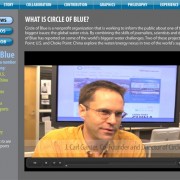
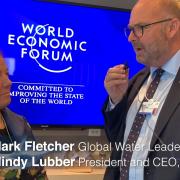
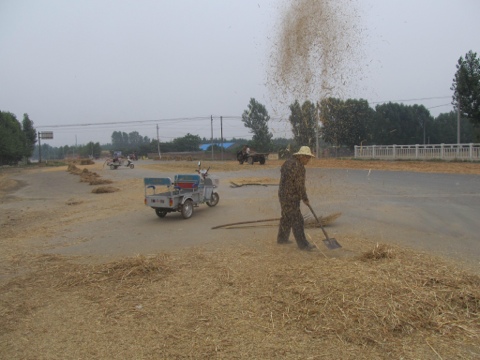
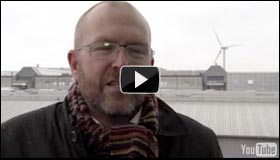

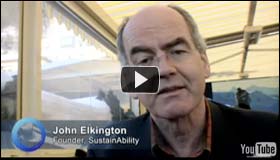
Leave a Reply
Want to join the discussion?Feel free to contribute!